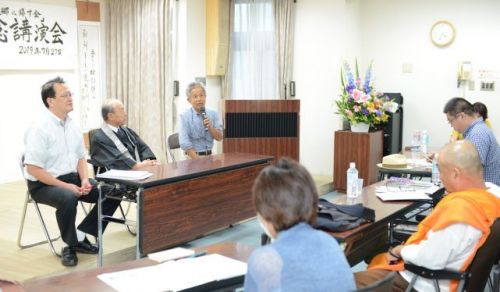“Association for Returning Remains to their Homeland” established for joint Japan-South Korea collection of Battle of Okinawa remains in Kenken, Motobu, Okinawa

Takamatsu Gushiken discussing the current state of remains collection at the inauguration of the “Association for Returning Remains in Kenken, Motobu to their Homeland,” which was established to return remains located in Kenken, Motobu to the families of the deceased
July 28, 2019 Ryukyu Shimpo
On July 27, a group called “Association for Returning Remains in Kenken, Motobu to their Homeland” was established with the aim of collecting the remains of fourteen people, including Koreans mobilized during the Battle of Okinawa, that were found in Kenken, Motobu, and returning them to the families of the deceased.
Next year will mark 75 years since the fourteen lost their lives, and the association hopes to have Japanese and South Korean citizens work together to collect remains as early as next February, hoping that the collection of remains will serve to form a bridge of peace and friendship between the two nations.
It hopes to have students from both countries join in the collection of remains, and will start a trial digging survey as early as this fall.
Regarding the remains found in Kenken, Motobu, a photograph of fourteen grave markers with Sesoko Island in the background was published in Life Magazine on May 28, 1945.
It was revealed that twelve of the fourteen were passengers of the Hikosan Maru ship, which was attacked and sunk off the coast of Motobu on January 22, 1945.
In June 2017, the Ryukyu Shimpo reported on the basis of interviews with residents living near the burial site that the remains might still be buried there.
After reading this report, Members of the volunteer group Gamafuya, which works on collecting remains of those who died in the Battle of Okinawa, and South Korean civic groups visited the site and agreed to work together on collecting the remains.
In a subsequent survey they made contact with the families of several of the Japanese and Korean deceased based on the names written on the grave markers.
On July 27, the association held an inaugural event in Ginowan. Takamatsu Gushiken of Gamafuya, priest Kouryu Okada, and Fukiko Okimoto of the NPO Okinawa Han no Hi were selected as co-representatives of the association.
“[Koreans too] were killed in the war [just like Japanese]. It’s only natural to offer consolation to all without differentiating by nationality.
I also want youth to come face to face with the fact that these people were killed in the war,” said Gushiken.
He expressed his hope to see youth from Japan and South Korea join hands and participate in the collection of remains.
“There is no doubt that to the surviving families on the Korean peninsula, the war and colonial rule have yet to be resolved after all this time,” said Yoshihiko Tonohira, who has been central to efforts to return remains of Koreans who died in the Shumarinai region of Hokkaido during the war to their families.
Keiji Ueda of the Return War Victims’ Remains to their Families Liaison Committee discussed the negotiations his group has engaged in with the government.
(English translation by T&CT and Sandi Aritza)
Previous Article:See the clip of Gov. Tamaki taking the stage at Fuji Rock
Next Article:Peace education workshop for Nakagusuku Village K-12 faculty takes place at war site
[Similar Articles]
- Memorial ceremony held for Koreans mobilized during war, exhumation in May
- Japanese and South Korean groups to perform joint survey of Motobu burial site
- Participants from Japan, South Korea, and Taiwan search for remains of Battle of Okinawa victims in Kenken, Motobu, wish for peace in East Asia
- Association of War-Bereaved Families protests soil collection plan for construction in Henoko
- Law passed to promote collection of war victim remains
 Webcam(Kokusai Street)
Webcam(Kokusai Street)


